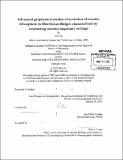Advanced geophysical studies of accretion of oceanic lithosphere in Mid-Ocean Ridges characterized by contrasting tectono-magmatic settings
Author(s)
Xu, Min
DownloadFull printable version (37.93Mb)
Other Contributors
Woods Hole Oceanographic Institution.
Advisor
Juan Pablo Canales.
Terms of use
Metadata
Show full item recordAbstract
The structure of the oceanic lithosphere results from magmatic and extensional processes taking place at mid-ocean ridges (MORs). The temporal and spatial scales of the variability of these two processes control the degree of heterogeneity of the oceanic lithosphere, represented by two end-member models: the classical Penrose Model exemplified by layered magmatic crust formed along fast-spreading MORs, e.g., East Pacific Rise (EPR); and the recently defined Chapman Model describing heterogeneous mafic and ultramafic lithosphere formed in settings of oceanic detachment faulting common along slow-spreading MORs, e.g., Mid-Atlantic Ridge (MAR). This thesis is using advanced marine geophysical methods (including finite-difference wave propagation modeling, 3D multi-channel seismic reflection imaging, waveform inversion, streamer tomography, and near-bottom magnetics) to study lithospheric accretion processes in MORs characterized by contrasting tectono-magmatic settings: the magmatically dominated EPR axis between 9°30'-10°00°N, and the Kane Oceanic Core Complex (KOCC), a section of MAR lithosphere (23°20°-23°38°N) formed by detachment faulting. At the EPR study area, I found that the axial magma chamber (AMC) melt sill is segmented into four prominent 2-4-km-long sections spaced every -5- 10 km along the ridge axis characterized by high melt content (>95%). In contrast, within the intervening sections, the AMC sill has a lower melt content (41-46%). The total magma volume extracted from the AMC sill was estimated of ~46 x 106 M3, with ~24 x 106 M3 left unerupted in the upper crust as dikes after 2005-06 eruption. At the KOCC, I used streamer tomography to constrain the shallow seismic velocity structure. Lithological interpretation of the seismic tomographic models provides insights into the temporal and spatial evolution of the melt supply at the spreading axis as the KOCC formed and evolved. Investigation of a magnetic polarity reversal boundary in crosssection at the northern boundary of KOCC suggests that the boundary (representing both a frozen isotherm and an isochron) dips away from the ridge axis along the Kane transform fault scarp, with a west-dipping angle of ~45° in the shallow (<1 km) crust and <20° in the deeper crust.
Description
Thesis (Ph. D.)--Joint Program in Oceanography (Massachusetts Institute of Technology, Dept. of Earth, Atmospheric, and Planetary Sciences; and the Woods Hole Oceanographic Institution), 2012. Cataloged from PDF version of thesis. Includes bibliographical references.
Date issued
2012Department
Joint Program in Oceanography; Woods Hole Oceanographic Institution; Massachusetts Institute of Technology. Department of Earth, Atmospheric, and Planetary SciencesPublisher
Massachusetts Institute of Technology
Keywords
Joint Program in Oceanography., Earth, Atmospheric, and Planetary Sciences., Woods Hole Oceanographic Institution.